We discuss factors that make a good pair of bone conduction headphones and share our top ten favorite picks.
| Name | IP Rating | Battery Life | Connectivity | Price |
|---|---|---|---|---|
| Shokz OpenRun Pro Best Overall | IP55 | 10 hours | Bluetooth 5.1 | BUY |
| Mojawa Mojo1 Strong Runner-Up | IP67 | 8 hours | Bluetooth 5.0 | BUY |
| Tayogo S2 Best Budget | IP55 | 6 hours | Bluetooth 5.0 | BUY |
| H2O Audio Sonar Best for Swimming | IPX8 | 7 hours | Bluetooth 5.0 | BUY |
| Shokz OpenComm Best for Calls | IP55 | 16 hours | Bluetooth 5.0 | BUY |
| YouthWhisper Lite Bone Conduction Headphones Best for Running | IP54 | 8 hours | Bluetooth 5.0 | BUY |
| Monster Open Ear Best for Gaming & Music Listening | IPX5 | 7 hours | Bluetooth 5.3 | BUY |
| GZCRDZ Wired Bone Conduction Headphones Best Wired | N/A | N/A | 3.5mm or USB-C | BUY |
| Forbrain Auditory Feedback Headphones Best for Auditory Processing | N/A | N/A | N/A | BUY |
| Erssimo H18 Pro Best for Kids | IPX5 | 8 hours | Bluetooth 5.2 | BUY |
How to Pick the Best Bone Conduction Headphones
Bone conduction headphones (also called jawbone or inductive headphones, or “bonephones”) use transducers to change audio signals into vibrations. These vibrations then travel to the inner ear via the bones in your cheeks and jaw.
Unfortunately, choosing the right pair of bonephones can be difficult. They’re in a league of their own, so you can’t compare them to traditional headphones. They also fulfill a purpose for consumers with specific needs, meaning the criteria for choosing good bonephones are slightly different.
To help simplify things, we’ll outline factors to consider when selecting the right pair of bone conduction headphones. Also included are the top ten bone conduction headphones on the market today. Let’s dive in!
Comfort & fit
Bone conduction and regular headphones are similar in that both have two earpieces connected by a headband to hold them in place. What sets the former apart is that they have no earbuds or ear cups that block or cover the ear canals. Instead, they use magnetostriction drivers placed over the jaw/cheek area.
One downside is that listening at higher volumes produces stronger vibrations that may cause discomfort. So, you should look for features that help reduce it.
That said, go for bonephones that feel snug but not too tight. This keeps them in place while providing long-wearing comfort. Flexible materials are also necessary. Many bonephones have rigid plastic designs that later feel painful. Instead, choose ones with a rubberized or silicone finish that feels softer on the skin.
Durability
The open-ear design of bone conduction headphones offers more spatial awareness, making them an excellent choice for urban athletes who want to exercise safely. So, durability is crucial if you mainly intend to use these headphones outdoors.
Regarding durability, you’ll want to consider IP ratings and build.
IP ratings (Ingress Protection) tell you how protected a device is from dust (first digit) and moisture (second digit).
To keep your headphones safe from rain and sweat, go for an IPX4 rating that protects them from water splashes. But, if you are planning to use them while swimming, go for at least an IPX8 rating, which lets you immerse your headphones in up to 1 meter of water.
As for the build, some bonephones feature rickety plastic materials, particularly on the headband. This isn’t ideal for outdoor use as they could break easily if bent. To avoid this, go for headphones made from sturdier materials like titanium.
Wireless or wired connectivity
The debate on whether wired or wireless headphones are better will probably never end. Both types have their advocates and valid arguments. Ultimately, the choice is yours and based on your personal preferences.
In the table below, we’ve listed the pros and cons of both wired and wireless headphones. Hopefully, they can help you narrow down your choice.
Wired headphones
- No signal interferences and latency (delayed audio) problems.
- There are no batteries to charge. This feature eliminates the possibility of being cut off during voice or video calls.
- Plug and play function makes them easy to operate. Headphones that require a USB connection will install their drivers automatically.
- The lack of internal batteries or circuits for wireless connectivity means they’re more affordable.
- The cable can become obtrusive and get in the way of movement.
- If non-replaceable cables are damaged, you’ll have to buy a new pair of headphones.
- The cable keeps you tethered to a device, significantly limiting your mobility.
Wireless headphones
- More freedom of movement. Only the operating range of your device limits you.
- There are no dangling cables to hinder movement.
- Compatible with most Bluetooth devices.
- Prone to signal interference and unsynchronized audio in real-time.
- They require constant charging and are useless when fully drained.
- They’re more expensive than wired headphones.
That said, it’s worth noting that most bone conduction headphones sold in the market today are wireless. You may have to put some effort into finding good wired ones, as we’ll see later in our best bone conduction headphones list.
Sound quality
Those looking for audiophile-level sound quality sadly won’t find it here. Their unique design poses a challenge when replicating the entire frequency range perceivable to humans. As such, regular headphones still outperform bonephones in this department.
Some manufacturers, however, have taken steps to improve the sound quality of their products. For instance, the Monster Over-Ears use bone and air conduction to enhance audio. Similarly, other headphones like the Mojawa Mojo1 use maglev vibrators for a more robust bass.
Others also feature software enhancements such as TurboPitch or PremiumPitch technology. These types of tech, in particular, boost audio volume and bass on Shokz headphones.
Generally, most bone conduction headphones are decent enough for casual music listening and podcasts. But if you prefer better audio quality, prioritize the features mentioned above.
Purpose
Some bone conduction headphones offer extra features that help in certain circumstances. So, if you have a specific purpose for buying bonephones, it’s good to look out for these additional features. Here are a few samples:
Bone conduction headphones as a hearing aid
Bonephones have roots in hearing aids. They’re ideal because they bypass the damaged eardrums and send sound straight to the inner ear. As a result, they allow those with hearing loss to perceive sound better.
In addition, some bonephones can help with more specific hearing-related problems. For instance, the Forbrain headphones improve auditory processing for better speech and memory. So if you’re looking for something more specialized, keep an eye out for features like this.
Bone conduction headphones for outdoor & water sports
This type of headphones has always targeted active people and sports enthusiasts since their release in 2008. With the combination of excellent durability and a lightweight design that promotes greater spatial awareness, it’s no surprise why.
In addition to high IP ratings, some bonephones, like the H20 Audio Sonar headphones, also feature internal memory that lets you store music and podcasts for hassle-free listening. This feature is handy since Bluetooth does not travel far underwater.
Bone conduction headphones for calls
Many bone conduction headphones come with built-in mics for calls. But if you need something that can keep up with you in an office or work-from-home setting, some offer additional features to help with that.
For instance, headphones like the Shokz OpenComm come with advanced DSP noise cancellation, making them ideal for noisy workplaces. And instead of a built-in mic, they feature a boom mic that more accurately picks up your voice, so you sound clearer on calls.
10 Best Bone Conduction Headphones in 2023
Shokz OpenRun Pro
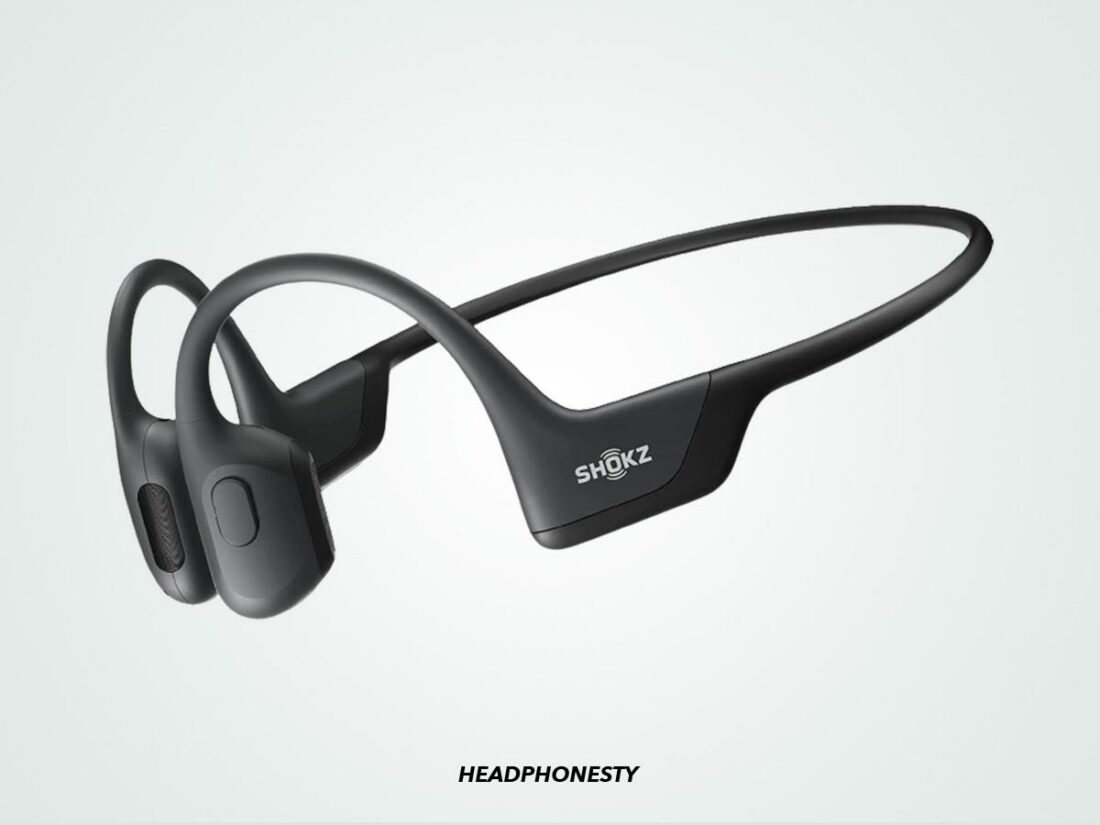
Key features
- IP Rating: IP55
- Weight: 29 g (1.02 oz)
- Battery Life: 10 hours
- Inline Controls: Yes
- Microphone: Yes
- Connectivity: Bluetooth 5.1
- Additional Features: Shokz TurboPitch™ Technology, Moisture Detection Alert, Dual Noise-Canceling Microphone
The Shokz OpenRun Pro headphones are expertly-designed, durable, and have features that make them ideal for music listening, taking calls, and working out. They’re fantastic all-around headphones and easily top our list of the best bone conduction headphones.
Bonephones typically aren’t known for impressive sound clarity and detail. However, the OpenRun Pro deliver exceptionally well in this department.
The combination of TurboPitch™ technology and dual bass enhancers adds more oomph to bass-thumping genres like EDM and Hip-Hop, which we really loved. Although they’re far from traditional studio headphones, the OpenRun Pro stand out the most among all the bone conduction headphones we’ve tested.
Moreover, these headphones are 20% smaller than older Shokz models, offering greater comfort. The thin design is easy to wear for long hours at work or outdoors, and they don’t get in the way regardless of what you’re doing. It’s all too easy to forget you have them on.
These bonephones are also great for work. The dual noise-canceling mics keep all those important conversations clear and disruption-free. And the fact that they’re IP55-rated means you can keep them on if you need to pop out for an errand and not worry about wet weather destroying them.
As an added precaution, the headphones also have a moisture detection function. The bonephones vibrate, and the indicator lights will flash blue and red to alert you that the charging port is wet.
Mojawa Mojo1
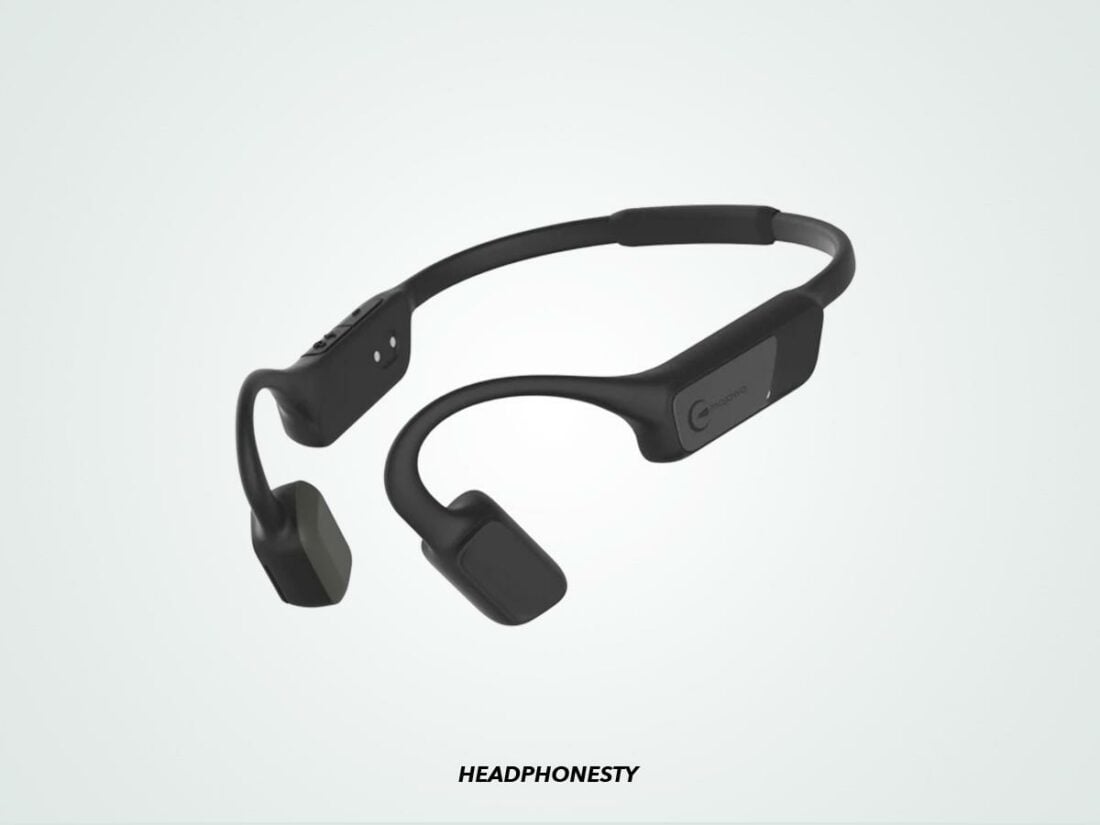
Key features
- IP Rating: IP67
- Weight: 34 g (1.19 oz)
- Battery Life: 8 hours
- Inline Controls: Yes
- Microphone: Yes
- Connectivity: Bluetooth 5.0
- Additional Features: Ultra-low Sound Leakage, Alula Reflective Strips, Maglev Bass Technology
The Mojawa Mojo1 bonephones are another great all-rounder for active folks. They feature a tough yet flexible build, great sound quality with reduced leakage, and a safety feature for night joggers.
Close to the OpenRun Pro, the sound quality on the Mojo1 bonephones is pretty dynamic and packs a nice punch, thanks to the additional magnetic bass vibrators. They also have slightly larger transducers and offer a more powerful listening experience.
Using the Mojo1 for office work is also effortless. The super thin build feels comfy after long hours, and the built-in mic lets you use voice assistants for effective multitasking. In addition, the smart noise-canceling feature lets you converse without distractions, and the 8-hour battery will last you all day.
With 90% less sound leakage, there’s no need to worry about blasting your tunes and disturbing any nearby co-workers.
Do you prefer listening to music on a nighttime run? No problem. The Mojo1 headphones come with two Alula Reflective Strips that you can attach to the headband. It’s an added safety measure that lets motorists see you when jogging in low-light urban areas. Moreover, using these headphones in the rain isn’t an issue with their IP67 rating.
Just as these headphones are light, they’re also pretty tough. The headband is memory titanium alloy, a highly elastic material that provides an ergonomic fit.
Tayogo S2
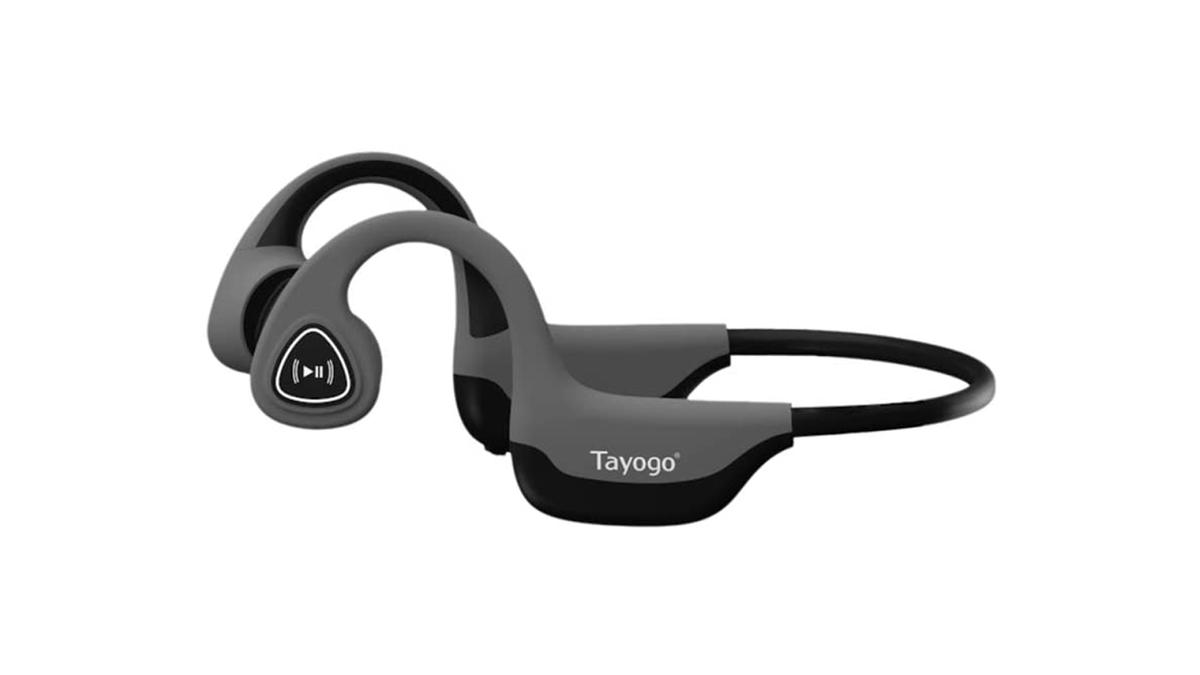
Key features
- IP Rating: IPX5
- Weight: 100 g (3.53 oz)
- Battery Life: 6 hours
- Inline Controls: Yes
- Microphone: Yes
- Connectivity: Bluetooth 5.0
The Tayogo S2 bone conduction headphones are your best option if you’re looking for a pair that won’t break the bank. They’re water-resistant and offer decent sound quality for their price. Also, they’re affordable for first-timers looking to try the technology without compromising quality.
Build-wise, these bonephones have a titanium and rubber frame that’s relatively comfortable when worn. The wrap-around design hugs the head perfectly, and the silicone pads sit snugly on the cheeks. For the most part, we had no issues with them moving or slipping during intense workouts.
These bonephones are also flexible enough that you can bend or rotate the headband 360 degrees without damaging it. And if you tend to sweat a lot, the IPX5 rating of the Tayogo S2 should set you at ease. This feature protects your headphones from water splashes in any direction.
The Tayogo S2 headphones also let you enjoy your music for as long as 6 hours on a single charge, while Bluetooth 5.0 allows you to pair with mobile devices and wearables quickly.
Moreover, some may find using the Tayogo S2 headphones in loud environments challenging. Though you could turn up the volume, this creates a noticeable tingling sensation on your cheekbones as the vibrations intensify. Doing so may also increase the sound leak in these headphones, which isn’t surprising, given that they are cheaper.
Also good: Panadia DG08
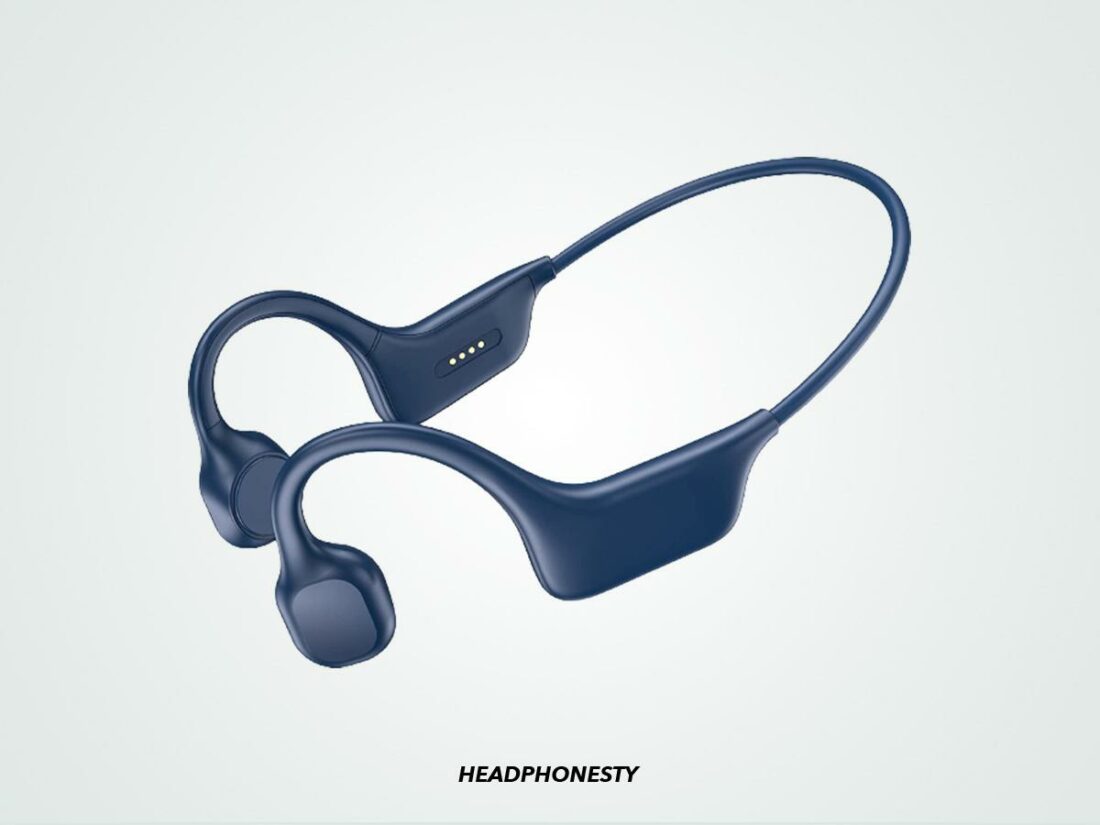
If you can’t afford the Tayogo S2, you can try the Panadia DG08 headphones, which cost less.
Both bonephones are almost identical. They have a lightweight, sturdy, and bendable build made from titanium. However, the Panadia DG08 headphones weigh less than the Tayogo S2 at only 26 grams. Both headphones have the same battery life of 6 hours and feature button controls that help manage media playback and calls.
As for playback, audio quality is pretty much at par with the Tayogo S2. They’re sufficient enough for casual listening, but that’s about it. And finally, although both headphones are water-resistant, the Panadia DG08 has a higher rating of IPX7 versus the Tayogo S2’s IPX5.
H2O Audio Sonar
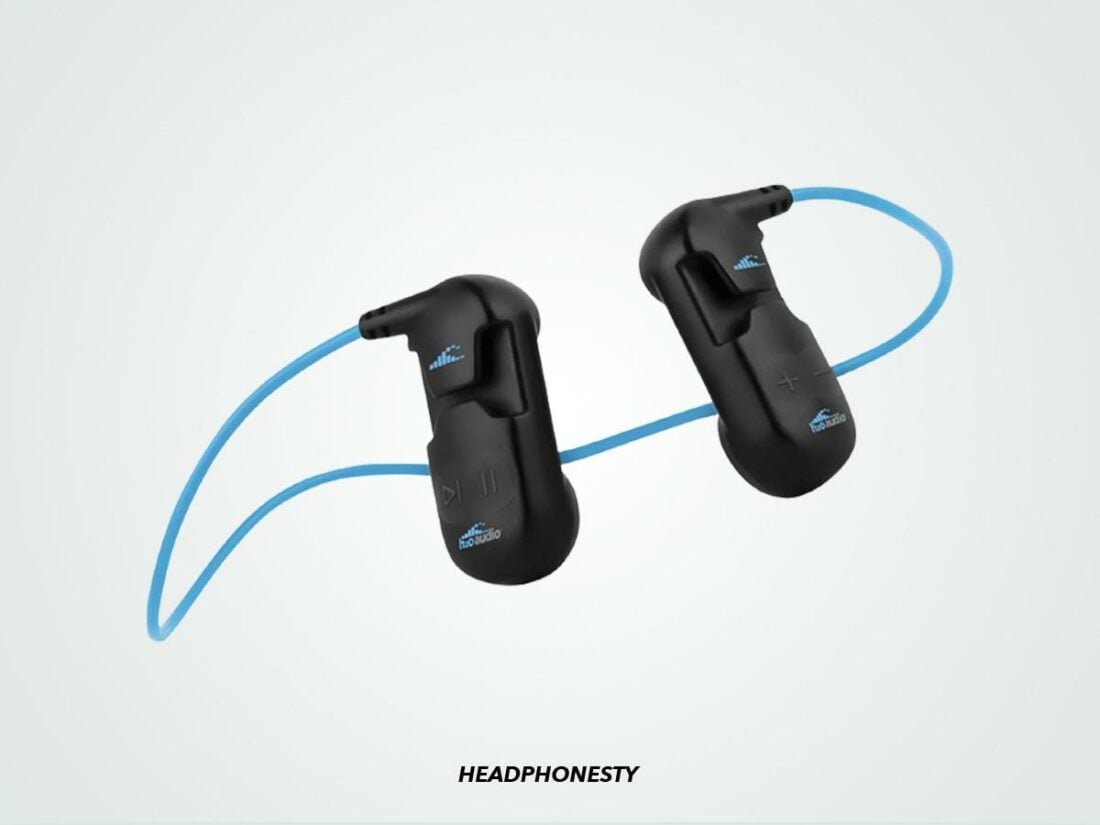
Key features
- IP Rating: IPX8
- Weight: 150 g (5.30 oz)
- Battery Life: 7 hours
- Inline Controls: Yes
- Microphone: No
- Connectivity: Bluetooth 5.0
- Additional Features: Built-in MP3 Player, 8GB Memory, Goggles-friendly Design
If you’re a professional swimmer or a water baby at heart, the H2O Audio Sonar headphones are perfect for you. They have a compact design that compliments goggle-wearers. You can also listen to music underwater because it has a built-in MP3 player and ample internal memory. As such, they’re our favorite bonephones for swimming.
With an IPX8 rating, these headphones have the highest water resistance on this list. They’re 100% waterproof and can survive continuous immersion in up to 12 feet of water.
So, if you fancy a bit of music while doing some laps, these bonephones are unbeatable.
Design-wise, these headphones feature a silicone strap and rubberized transducers for a comfortable but secure fit. There are also built-in slots on the transducers that you can slip your goggles strap through for a more seamless look. We love this little feature because it keeps the bonephones in place regardless of how vigorously you move underwater.
Bluetooth 5.0 lets you pair up with mobile devices and smartwatches. However, we did notice a reduced operating range while using the bonephones underwater. This observation is no surprise, as water is known to cause Bluetooth interference.
Fortunately, these bonephones have a built-in MP3 player with a memory capacity of 8GB. That’s good for 2,000 songs, which is more than enough. Adding music is also as easy as hooking the headphones to your computer via a USB cable. Then you can simply drag and drop songs into your headphones’ storage.
Despite all these, there are still a few minor drawbacks. First, they’re a bit heavier at 150 g than most headphones on this list. But that isn’t an issue since they’ll be virtually weightless underwater.
Also, although the headphones come with button controls for playback, there’s no option to shuffle songs. So, you’ll have to rearrange your song list on your computer or skip forward using the controls.
Also good: Relxhome Bone Conduction Headphones
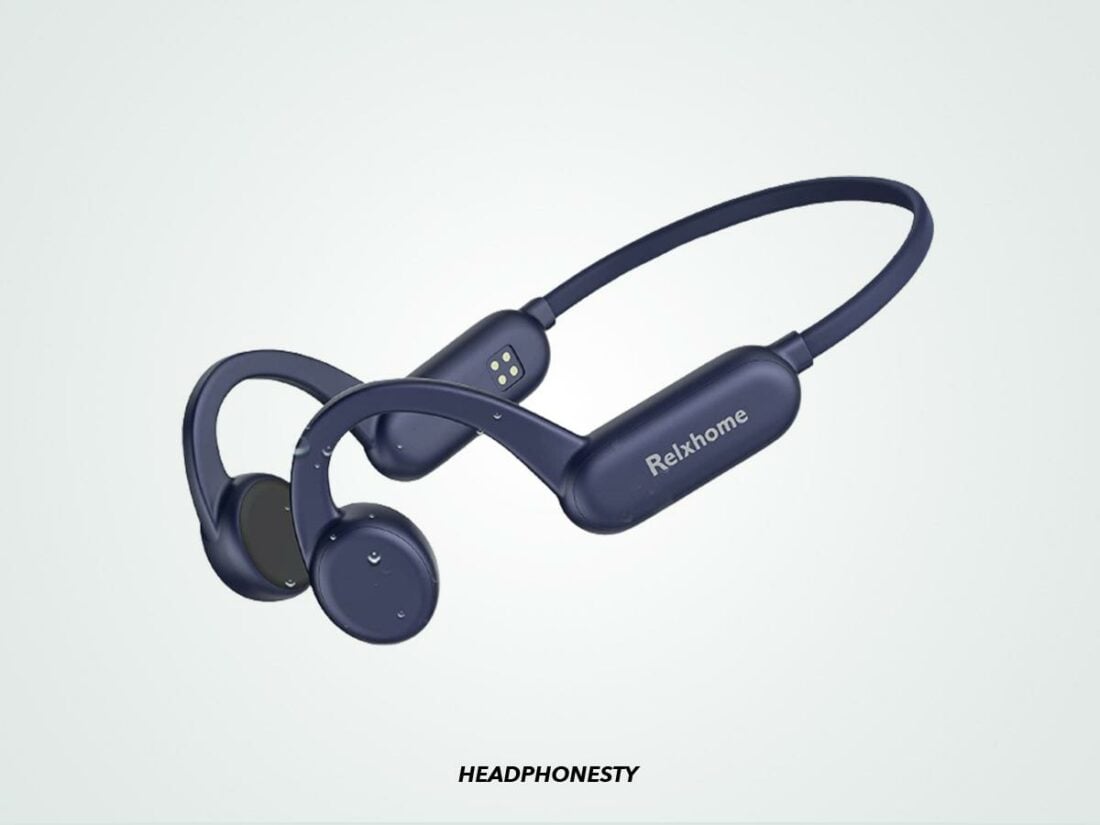
If you’re looking for something a little sturdier, these Relxhome bone conduction headphones may be just what you need. Like the H2O Audio Sonar, these have a built-in MP3 player with 8GB memory that supports MP3, FLAC, WAV, WMA, and AAC files. They’re also IP68-rated, making them completely waterproof and ready for the pool.
The H2O Audio Sonar bonephones have a “clip-on” design and a soft silicone strap that’s easy to wear and store. In contrast, the Relxhome bonephones feature the more traditional wrap-around headband that offers more durability. Both feel comfortable, so the choice depends on your personal preference.
However, what truly makes them different is that they come with a built-in mic, whereas the Sonars do not. So, if you’re adamant about never missing a call (not even while taking a dip), the Relxhome bonephones are for you.
Shokz OpenComm
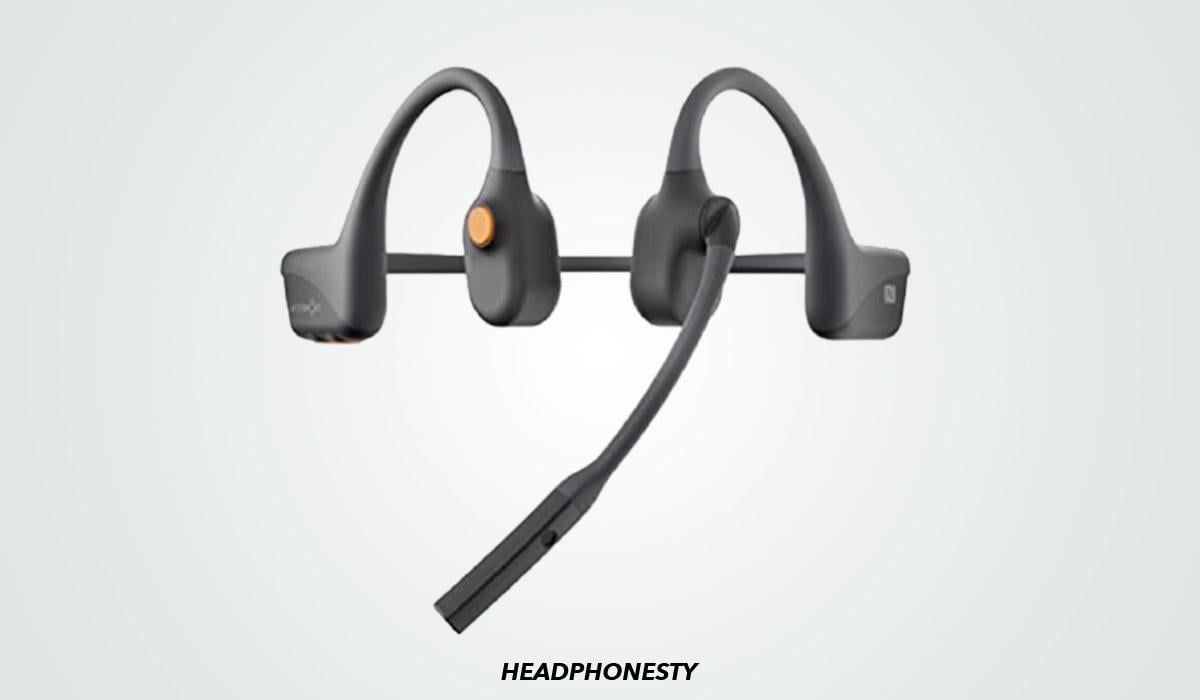
Key features
- IP Rating: IP55
- Weight: 33 g (1.16 oz)
- Battery Life: 16 hours
- Inline Controls: Yes
- Microphone: Yes
- Connectivity: Bluetooth 5.1
- Additional Features: PremiumPitch 2.0, Loop 100 USB-A Wireless Adapter (OpenComm UC), Quick Charge
The Shokz OpenComm headphones feature a sleek, professional look suited for remote and office workers. Also, the super-thin boom mic is not intrusive and delivers clear vocals on video and voice calls. For these reasons, they’re our favorite bone conduction headphones for calls.
The mic placement on the OpenComm differs from older Shokz models in that they’re placed closer to the mouth for better voice pickup. So, those upgrading from an older Aeropex, for example, will notice a considerable change in voice and audio quality.
Advanced DSP noise cancellation also filters your voice cleanly from surrounding ambient sounds. This feature works remarkably well to ensure your voice sounds loud and clear, even in extremely noisy places.
These multi-awarded bone conduction headphones feature exceptional audio quality too. With PremiumPitch 2.0 technology, they equalize medium and high frequencies in voices. Together, they ensure you never miss a beat during business calls.
Additionally, these headphones allow you to connect quickly and efficiently to laptops, PCs, and mobile devices with Bluetooth 5.1. And you can also opt for the OpenComm UC version. They come with the Loop 100 USB-A Wireless Adapter you can plug into your computer for a more stable Bluetooth connection.
The OpenComm are pretty comfortable and geared towards prolonged use. Their battery lasts up to 8 hours – enough to last an entire day in the office! There’s even a quick charge function that gives you 2 hours of playback on a 5-minute charge.
Though designed for office settings, the OpenComm works just as well outdoors. An IP55 rating means the transducers and mic are safe from dust and weather changes.
Also good: Klatre LS1
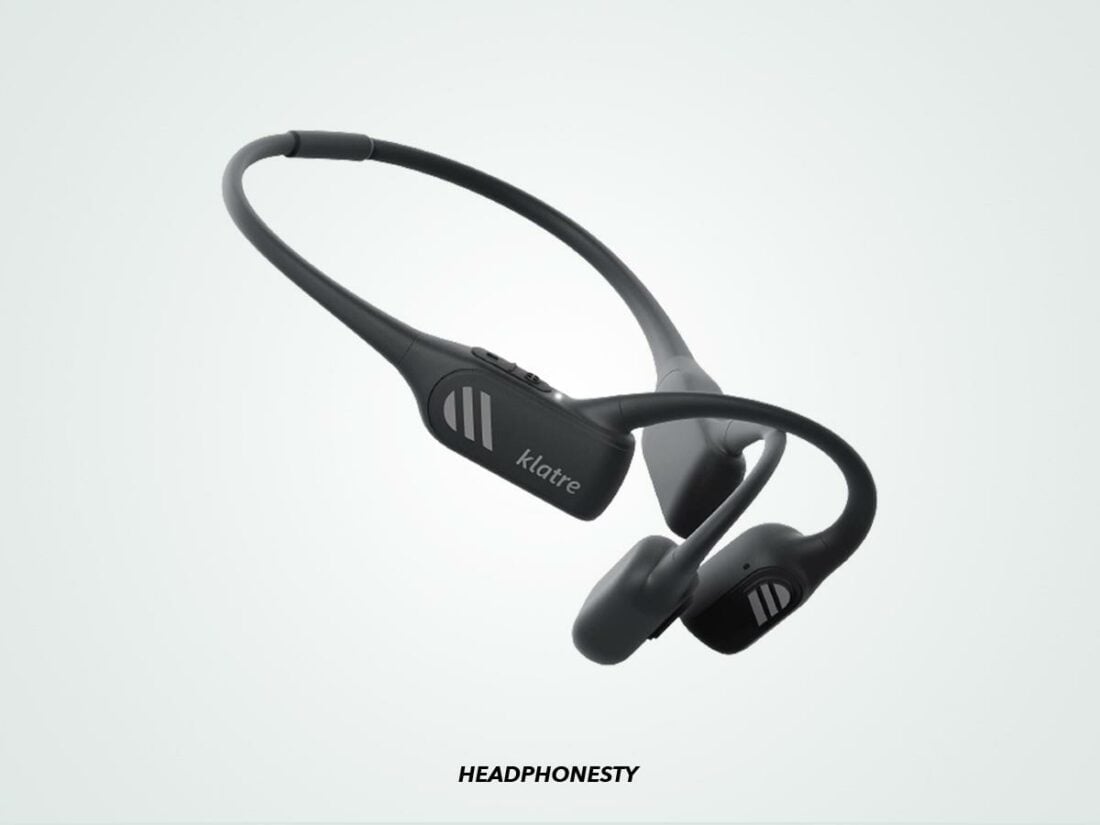
The Klatre LS1 bone conduction headphones are a cheaper alternative if you’re on a budget. Like the OpenComm, these bonephones have a sleek metal alloy frame that looks stylish and professional. They provide 8 hours of battery life and are IP55 water-resistant.
However, unlike the bonephones mentioned above, these do not have a boom mic. But they make up for it with dual environmental noise-canceling mics that reduce up to 60dB of background noise.
Regarding connectivity, the Klatre LS1 use Bluetooth 5.2, which is higher than the OpenComm. Unfortunately, they don’t offer peripherals like the Loop 100 Adapter to ensure a consistent connection when you need it.
YouthWhisper Lite Bone Conduction Headphones
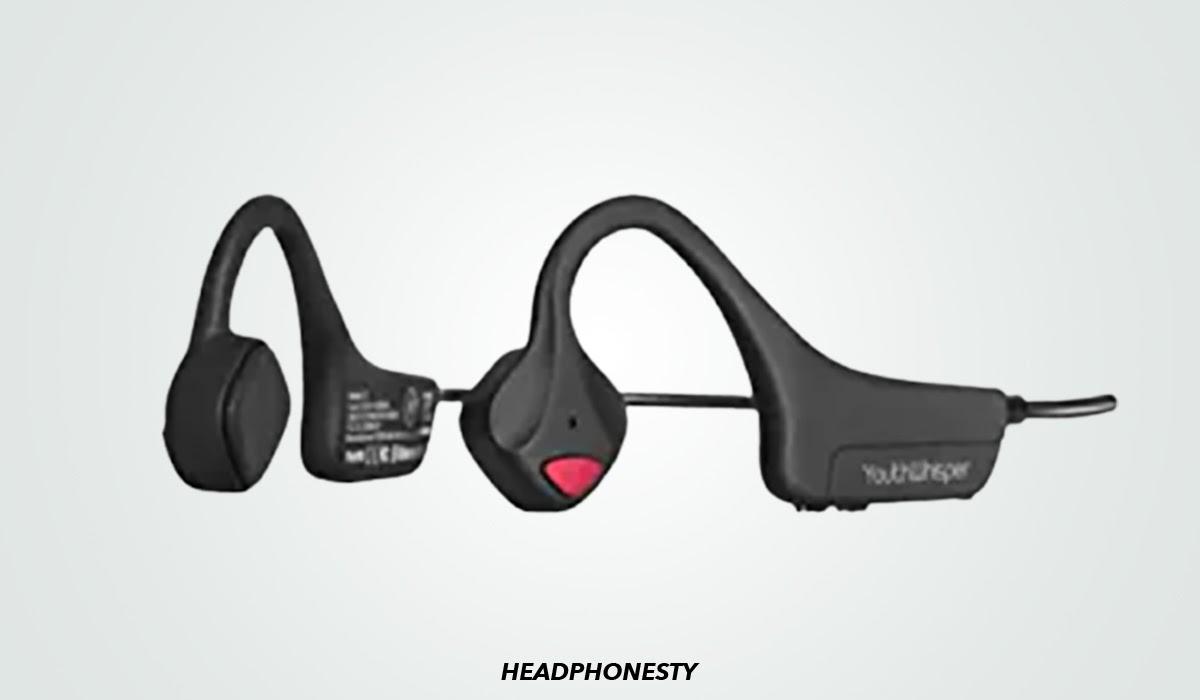
Key features
- IP Rating: IP54
- Weight: 24 g (0.88 oz)
- Battery Life: 8 hours
- Inline Controls: Yes
- Microphone: Yes
- Connectivity: Bluetooth 5.0
- Additional Features: Noise-proof Earplugs
The YouthWhisper Lite bone conduction headphones are a fantastic workout accessory for the perpetually active. Although positioned as midrange bonephones, they’re certainly not light on features. And at only 24 grams, they’re the lightest bonephones on this list, thus fitting for runners.
These bonephones have a flexible, ultra-thin titanium headband that wraps around the head for added security. In addition, the silicone pads feel comfy enough that you might even forget you’re wearing them. Both features hold your bonephones in place, whether you’re jogging or training for a marathon.
The 200 mAh lithium-ion battery fully charges in 2 hours and offers 8 hours of playback. On standby mode, they last for a whopping 480 hours. With fast charging, a 15-minute charge will give you about an hour of talk time.
Further, the sound quality is decent enough for casual listeners, so you’ll have no problem staying entertained while running laps.
The YouthWhisper Lite supports Bluetooth 5.0 and multi-pairing, which is useful when connecting to two devices simultaneously. So, you don’t need to disrupt your workout to disconnect from one gadget just to hear and answer another.
Lastly, an IP54 rating keeps them safe from sweat and rain, so you can keep going regardless of the weather.
Also good: Shokz OpenMove
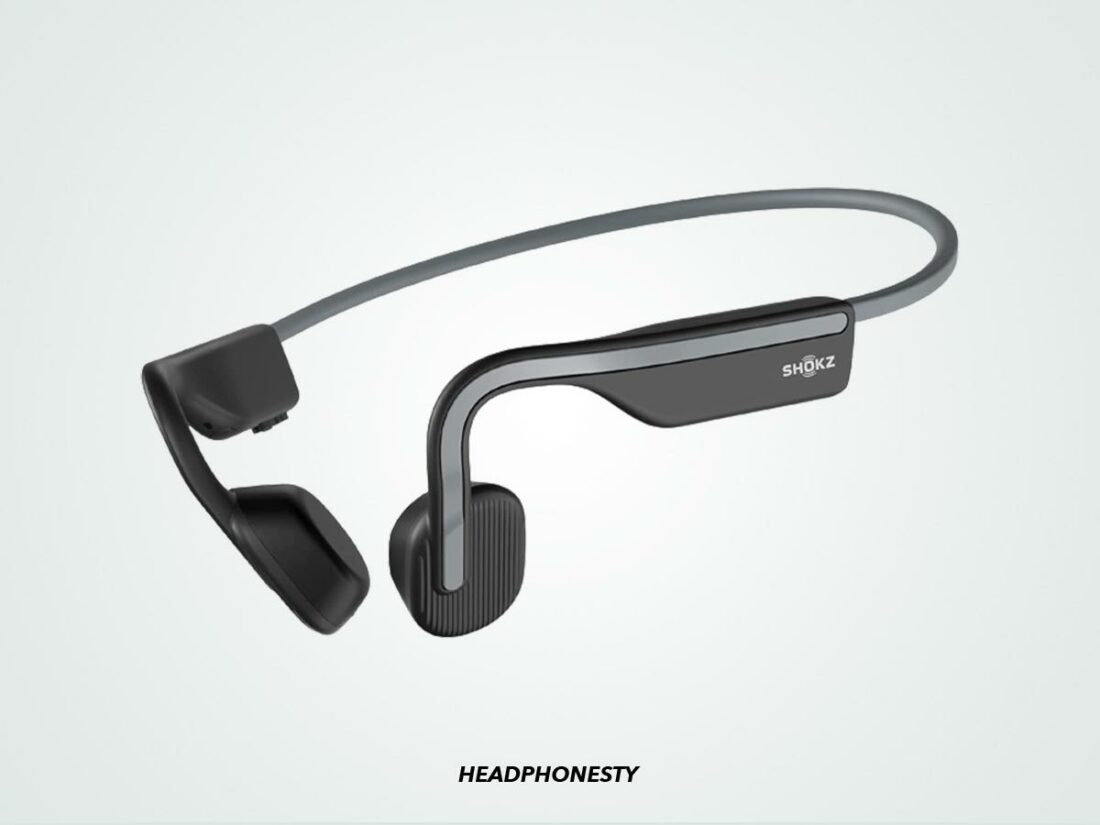
The Shokz OpenMove bone conduction headphones are another top-notch candidate for runners. Much like the YouthWhisper Lite, these have a lightweight build of only 29 grams. The headband is also titanium and silicone and feels rock solid even during intense runs.
Like other Shokz headphones on this list, the OpenMove comes with PremiumPitch 2.0 technology. They even have two EQ settings – Human Voice Mode and Standard Mode. The former boosts voices when listening to audiobooks or podcasts. And the latter provides balanced listening for music.
Lastly, the OpenMove bonephones feature Bluetooth 5.1 and a slightly higher water resistance rating of IP55. However, it also has a shorter battery life of 6 hours compared to the YouthWhisper Lite. Still, they make a good alternative for those who want slightly better sound quality.
Monster Open Ear
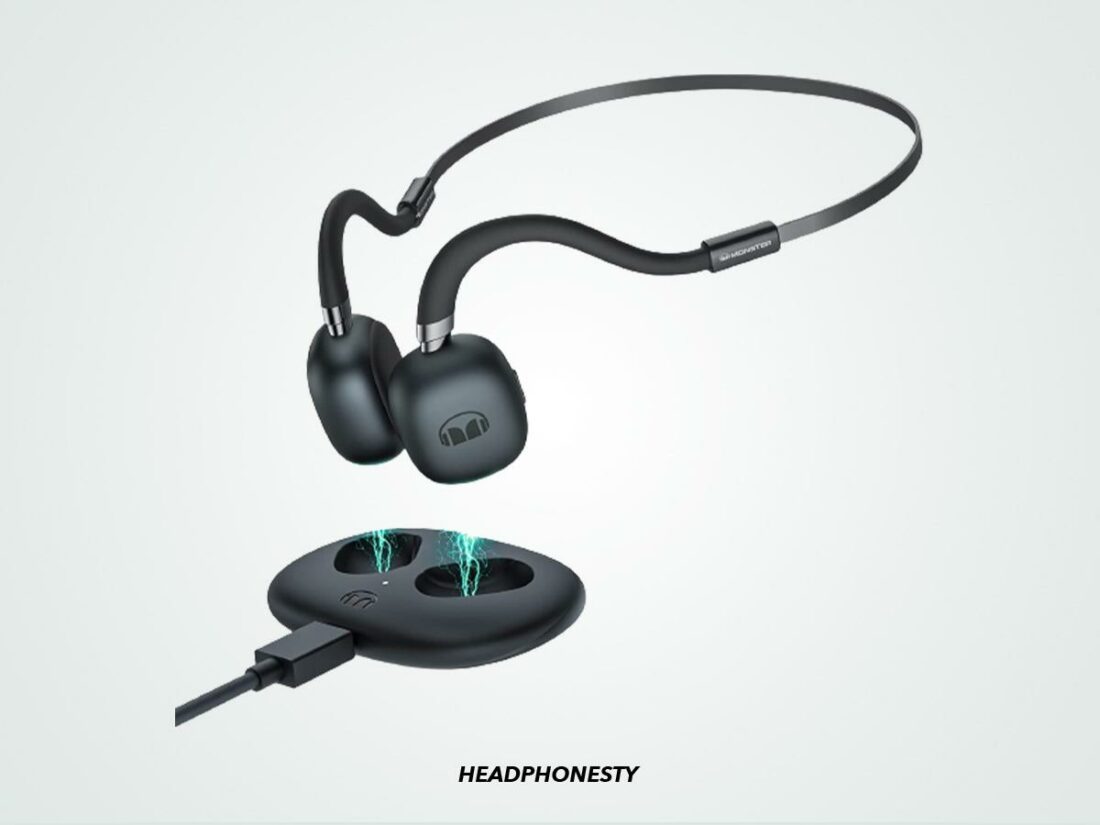
Key features
- IP Rating: IPX5
- Weight: 181 g (6.4 oz)
- Battery Life: 7 hours
- Inline Controls: Yes
- Microphone: Yes
- Connectivity: Bluetooth 5.3
- Additional Features: Bone and Air Conduction Technology, Gaming Mode
Are you looking to make gaming and music listening sessions more dynamic? Go for the Monster Open Ear bone conduction headphones. They feature a high-sensitivity mic, impressive sound quality, and low-latency connectivity, ideal for streaming and online gaming.
When it comes to sound, Monster has done its homework. Pure Monster Sound Technology is rooted in 40 years of sound engineering and delivers realistic sound quality. They also use a combination of bone and air conduction for better audio clarity and bass.
While the Monster Open Ear bonephones sound decently clear, we noticed more forward-sounding mids and highs during testing. As such, dialogue and vocals sound more prominent in video games and music, so they’re great for those who enjoy that sound profile.
We should also point out that positioning makes a big difference with these bonephones. The thin air conduction slots on the sides of the transducers must be facing your ear canal correctly for you to get the best sound quality. Otherwise, your audio may sound a bit weak or flat.
Bluetooth 5.3 ensures a seamless and stable connection with your devices. But you can take this further with the bonephones’ Gaming Mode. It reduces lag and latency to 60ms, so you’ll never fall behind the action when playing online.
The high-sensitivity noise-canceling mic also accurately picks up your voice so that you don’t need to yell at your co-players.
These headphones come with a handy magnetic charging dock. When you hold the bonephones near it, they immediately lock on. That means less time spent fiddling with your headphones to ensure you’ve plugged them correctly. Charging takes about 2 hours, and a full charge gets you 7 hours of use.
Notably, the build on these bonephones is not bad, either. The titanium alloy headband is highly resistant to wear and tear. Regardless of how much you bend them, they’ll retain their shape. An IPX5 rating also protects against sweat, rain, or accidental spills.
GZCRDZ Wired Bone Conduction Headphones
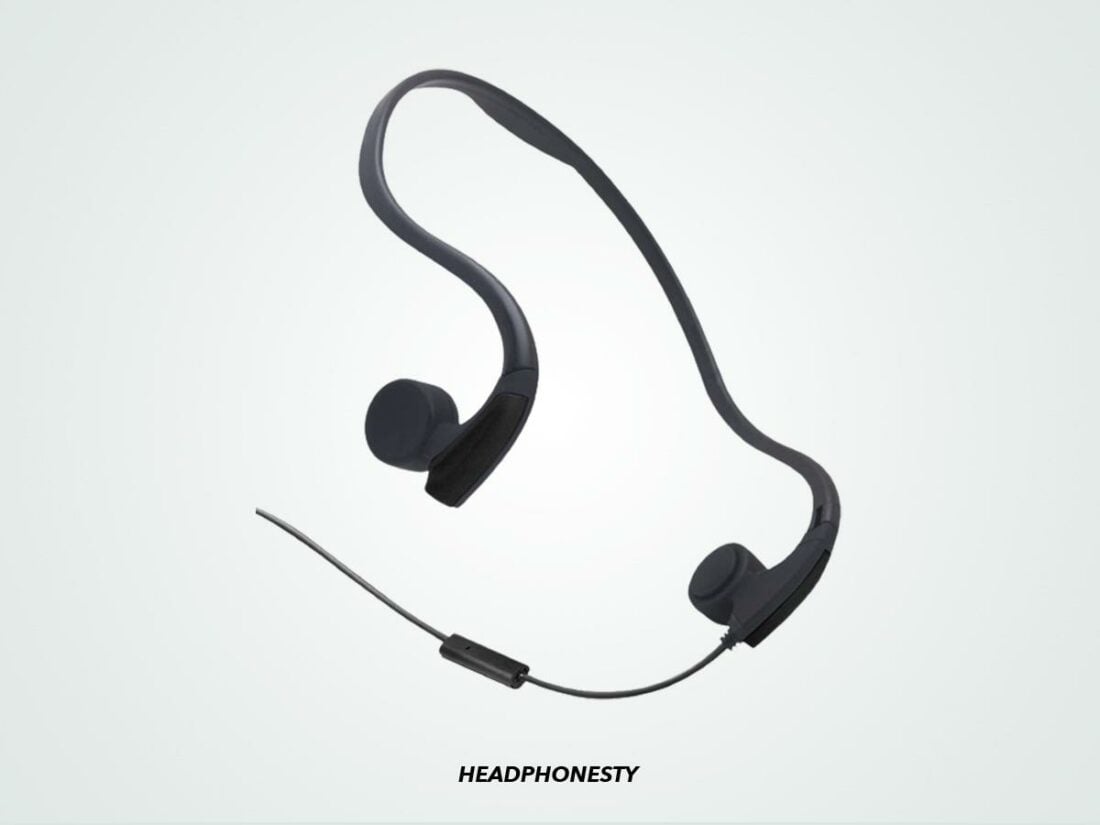
Key features
- IP Rating: N/A
- Weight: 20 g (0.7 oz)
- Battery Life: N/A
- Inline Controls: Yes
- Microphone: Yes
- Connectivity: 3.5mm or USB-C
- Additional Features: Type C Adapter Cable
If you’re looking for wired bonephones to use at your desk, check out the GZCRDZ Wired Bone Conduction Headphones. These bonephones are pretty plain when it comes to looks and features. But if you only want the open-ear technology without the other bells and whistles, they’re perfect.
These bonephones are also affordable and uncomplicated. They even have two optional wired connections for better versatility with different devices. A 3.5mm plug lets you use the bonephones on smartphones and computers, and you can swap that out with the included Type C adapter cable if needed.
The GZCRDZ Wired bonephones are not battery-powered and thus will draw power from connected devices. They also have a standard inline mic on the cable, with accompanying volume rockers.
Forbrain Auditory Feedback Headphones
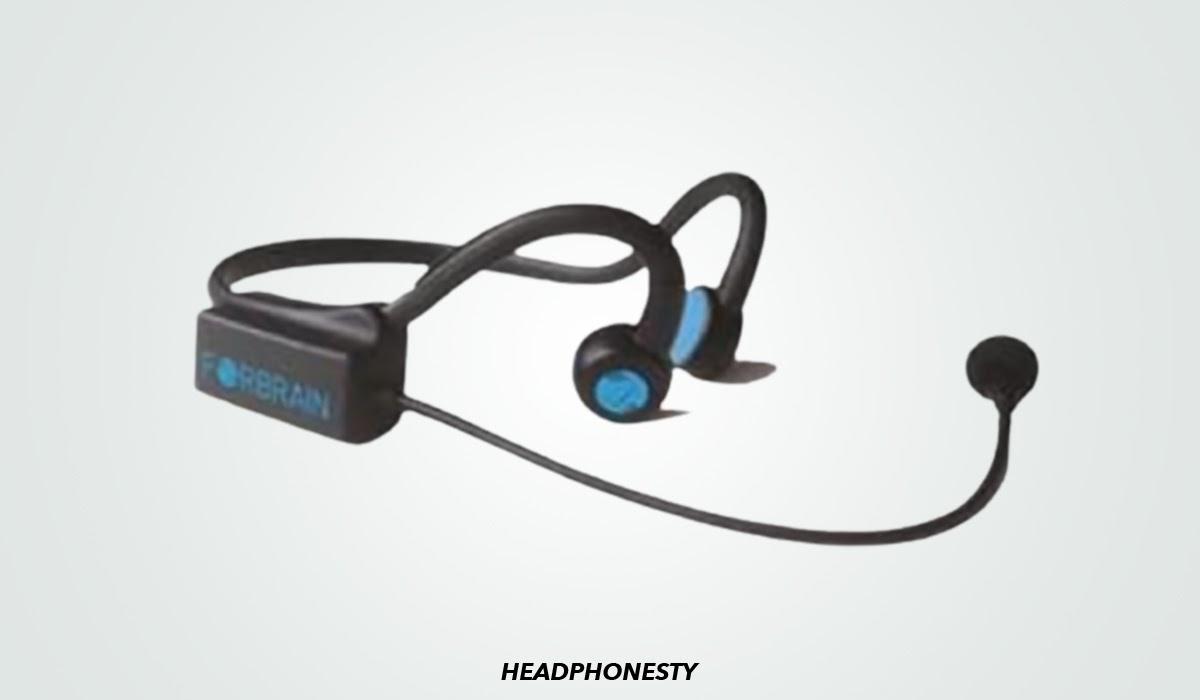
Key features
- IP Rating: N/A
- Weight: 50 g (0.11 oz)
- Battery Life: 6 hours
- Inline Controls: Yes
- Microphone: Yes
- Connectivity: USB to micro USB
- Additional Features: High-sensitivity Microphone, Patented Dynamic Filter
The Forbrain Auditory Feedback Headphones are a therapeutic tool for improving speech memory, focus, and cognitive processes. They’re unique because they’re the only pair of bone conduction headphones on this list marketed as an educational tool for those with speech delays and Autism Spectrum Disorder (ASD).
These bonephones help with the auditory feedback loop process by enhancing and modulating the sound of your voice through a patented dynamic filter. The sound is then sent back to you through the bone conduction transducers.
This process happens in real time and is ten times faster than air conduction. It also lets the wearer hear themselves better, allowing speech impediments to be corrected.
The quality inherent in the Forbrain bonephones is worth noting. The vocals produced by the Forbrain are clear and crisp, and the high-sensitivity mic does a fine job of capturing voices cleanly.
Designed for adults and kids, they sport a comfortable, lightweight build. And the headband and boom mic are thin and easy to wear, even for prolonged periods.
Unlike most bone conduction headphones, the Forbrain comes packaged in a large carrying case. This case can hold the headphones, manuals, and accessories, giving the Forbrain a premium, professional look.
Erssimo H18 Pro
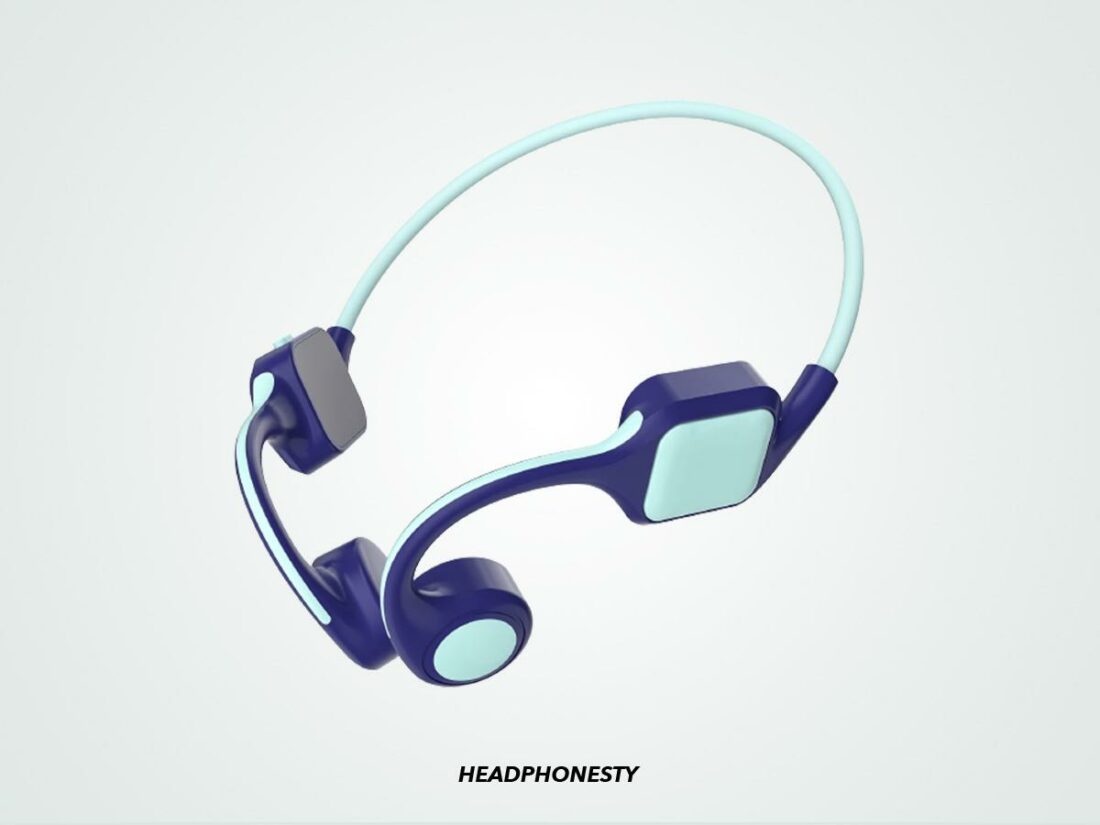
Key features
- IP Rating: IPX5
- Weight: 25 g (0.88 oz)
- Battery Life: 8 hours
- Inline Controls: Yes
- Microphone: Yes
- Connectivity: Bluetooth 5.2
- Additional Features: Upgraded Transducers, 360° Bendable Design, Volume Limiter
The Erssimo H18 Pro bone conduction headphones are a fun, colorful option for toddlers to teens. They cover all the bases in design, durability, and functionality, making them great for study and leisure.
Good hearing is crucial to a child’s learning and speech development. So, protecting their ears is paramount. With the Erssimo H18 Pros, you can rest easy knowing they serve this purpose well.
The upgraded transducers certainly provide better audio quality. There’s also less sound leakage and vibrations, so you don’t get that annoying quivering sensation when turning the volume up. The bonephones have two volume modes (Indoor and Outdoor) but also feature a built-in volume limiter to safeguard your kid’s ears and ensure audio isn’t needlessly loud.
The Erssimo H18 Pros weigh less than an ounce; even kids as young as three will have no problem wearing these bonephones. Usually, they come in two attractive colors that appeal to girls and boys alike and have a soft silicone finish that’s comfortable on children’s skin.
There’s no need to worry about hyperactive kids wearing these bonephones. The 360° bendable design offers enough flexibility to ensure they won’t get damaged from any mishaps. An IPX5 rating also means they’re safe from mild moisture exposure.
Fast pairing is possible with Bluetooth 5.2, and the dual microphones guarantee clear voice pickup for video calls and online classes. All in all, these bonephones make a great study partner for kids of all ages.
Notable Mentions
The competition is fierce in the bone conduction headphones market, and many bonephones didn’t quite make the cut in our top 10 list. However, there were a couple that we felt were still worth mentioning due to their outstanding features.
Shokz OpenRun
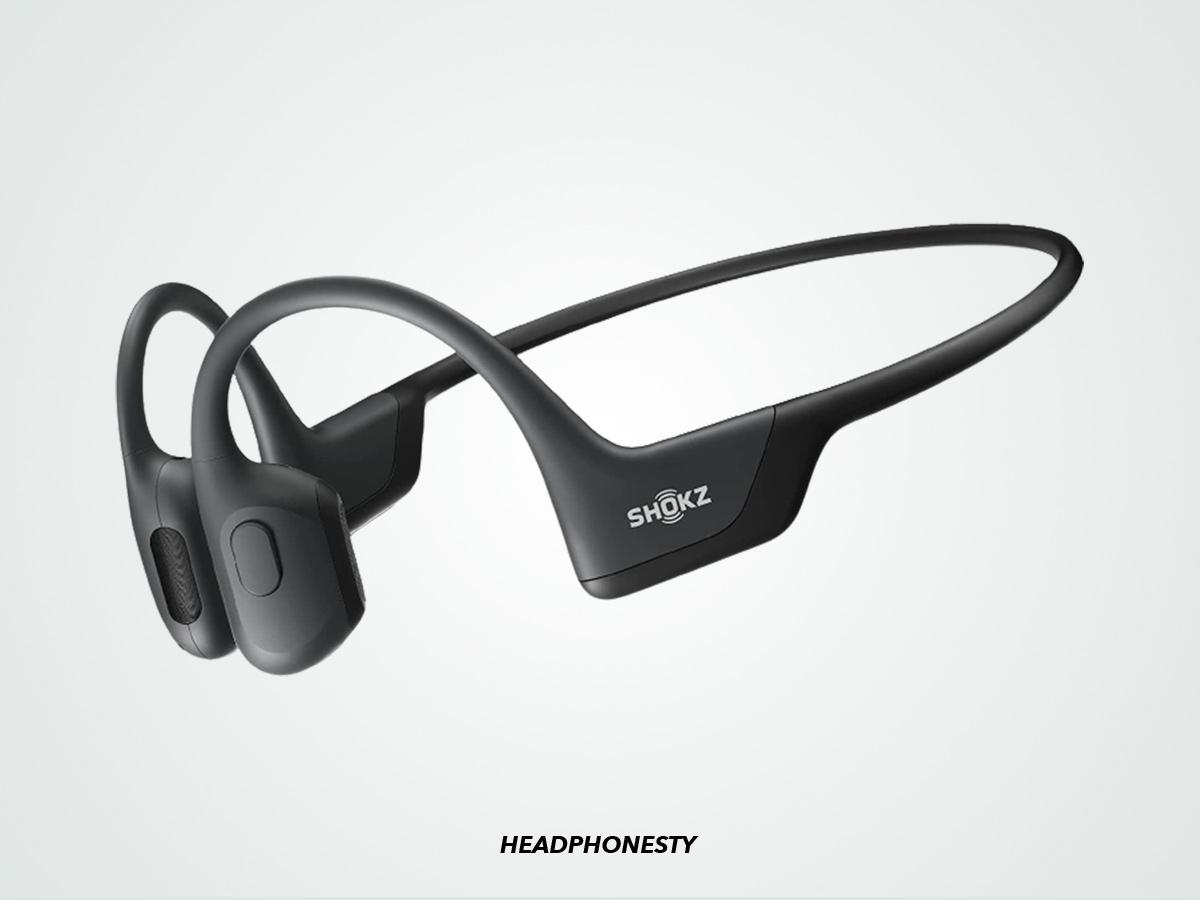
Key features
- IP Rating: IP67
- Weight: 26 g (0.92 oz)
- Battery Life: 8 hours
- Inline Controls: Yes
- Microphone: Yes
- Connectivity: Bluetooth 5.1
- Additional Features: PremiumPitch 2.0, Quick Charge, Moisture Detection Alert
With the Shokz OpenRun (formerly called the Aftershokz Aeropex), Shokz has added another product to its lineup of quality headphones. The OpenRun bonephones feel comfortable and lightweight, weighing less than an ounce. They also look exceptionally stylish with their matte rubber finish.
Like all other Shokz bonephones, the OpenRun have an extremely light and thin titanium frame. But their durability speaks for itself. You can bend these bonephones in various ways without damage, and they have enough clamping force to fit snugly on your head. More importantly, they never feel tight, even after extended use.
Volume and playback buttons are easily accessible on the transducer and headband. And when you press either one of them (while there’s no music playing), it will tell you the battery status. Not exactly groundbreaking, but it’s a convenient feature.
Overall, the sound quality is good. These bonephones are bassy (sometimes excessively so) with pronounced mids, making them great for electronic music genres. We especially liked how clear the vocals sound on these bonephones, so you’ll have no problems if you prefer listening to podcasts.
Battery life yields 8 hours of continuous playback. But if they’re running low on juice, a 10-minute charge is enough to get about 1.5 hours of use out of them.
In addition, pairing with other devices is painless with Bluetooth 5.1. The built-in microphone also does the job, albeit with some background noise during calls. With one of the highest IP ratings on this list, the OpenRun is ready for any weather. But don’t take them into the pool with you because they aren’t 100% waterproof.
Shokz OpenSwim
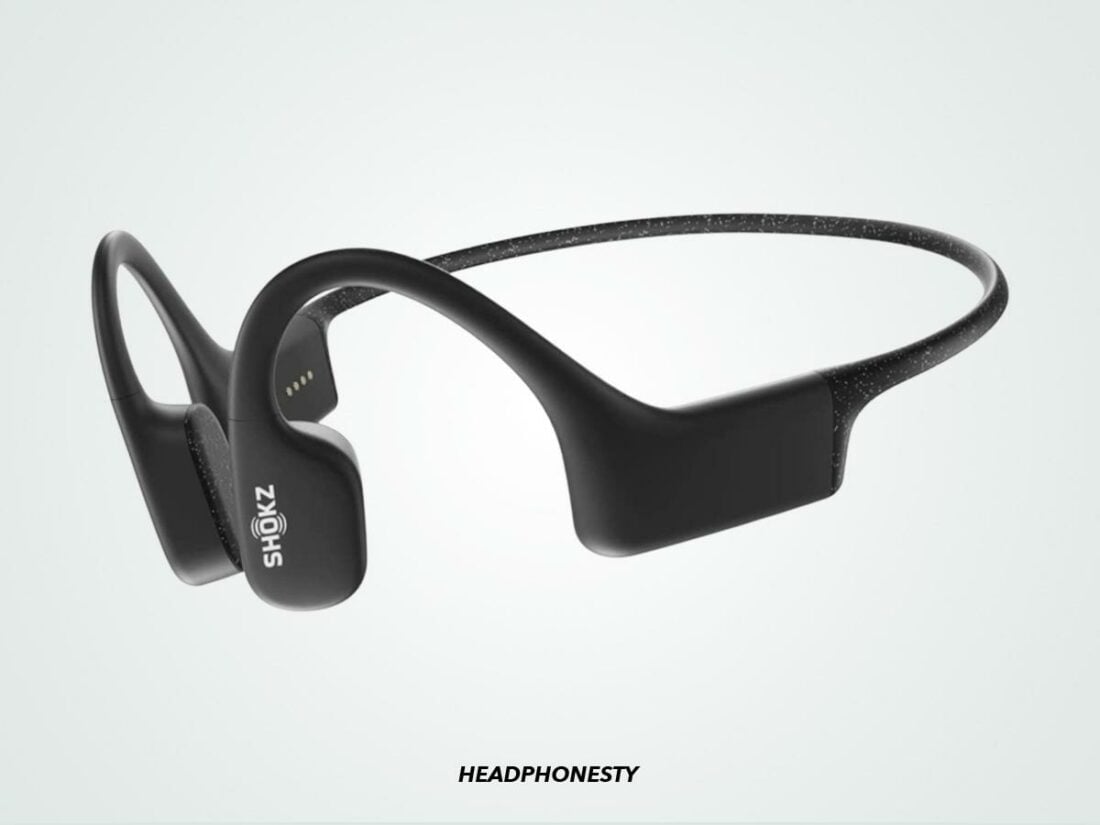
Key features
- IP Rating: IP68
- Weight: 30 g (1.06 oz)
- Battery Life: 8 hours
- Inline Controls: Yes
- Microphone: N/A
- Connectivity: N/A
- Additional Features: PremiumPitch 2.0 Technology, Swimming Earplugs
Shokz has been around since 2004 and has become the leading brand in bone conduction headphones. That’s why it’s not surprising that the Shokz OpenSwim are their fifth entry on this list.
Despite being a notable mention, these bonephones are another excellent option for swimmers. As expected, they have a completely waterproof build. You can use them in the pool, freshwater, or even saltwater if you’re more of a beach person.
There’s no Bluetooth connectivity on these bonephones. But you get a 4GB internal memory that lets you store 1,200 songs. Transferring songs onto your device is also fuss-free, thanks to the included USB charging cradle.
Simply insert the bonephones into the charger, then connect to your laptop via USB. Adding songs is as simple as dragging and dropping them from your desktop to the OpenSwim drive.
As with most bone conduction headphones, don’t expect the sound quality of OpenSwim to rival traditional headphones. However, they’re a few notches above other headphones of this type.
They have two EQ modes – General and Swimming – designed to improve audio. General Mode is decent, but the Swimming Mode EQ setting really enhances your audio so that your music sounds clear, even underwater. Also, the bass and mids sound great, and the effect is even better when wearing the included earplugs.
Frequently Asked Questions About Bone Conduction Headphones
How do bone conduction headphones work?
Knowing how sound travels into the inner ear is key to understanding this.
Sound reaches your inner ear via airwaves. It travels from an audio source and passes through the outer and middle ear until it reaches the cochlea. The sound is then processed into a signal and sent to your brain.
As long as sound can reach your cochlea, you can technically hear it.
On the other hand, bone conduction headphones take an alternate route. They send vibrations through the bones in your face to the temporal bone (the bone surrounding the cochlea). The vibrations cause cochlear fluid to move, sending signals to the auditory cortex where the sound is heard.
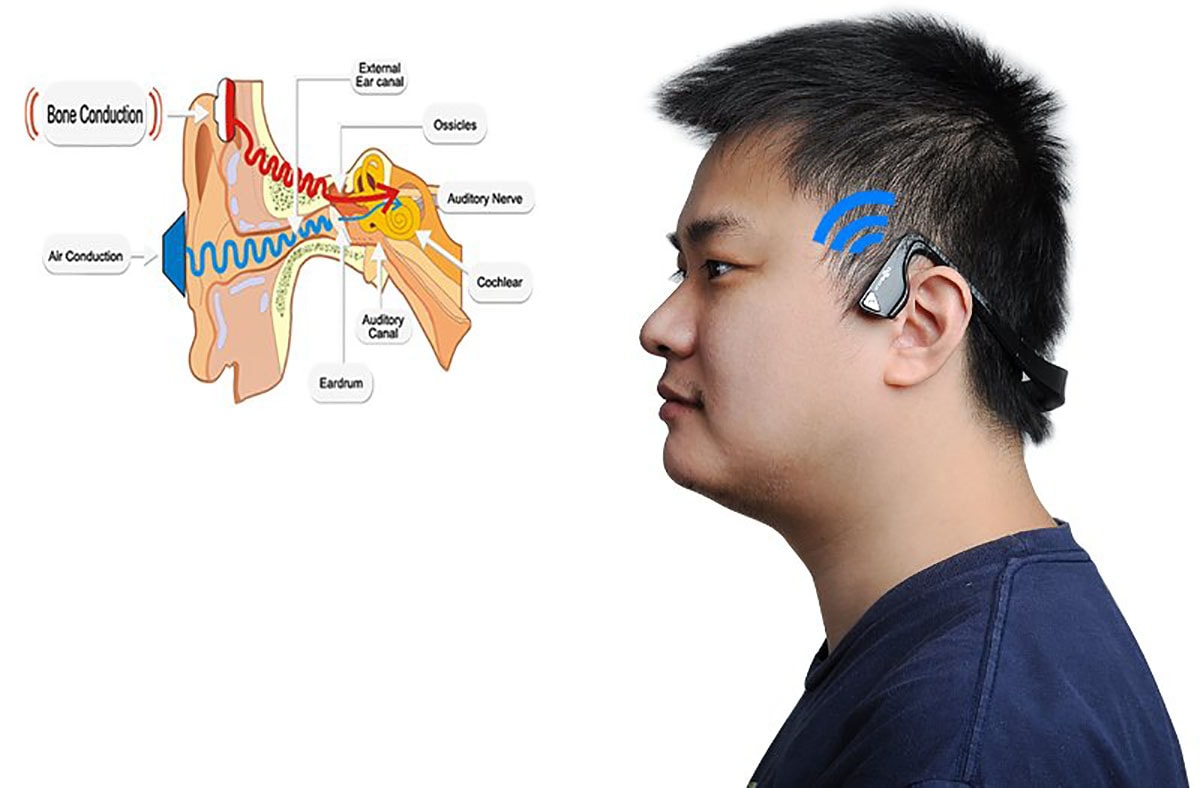
This technology is a lifesaver for people with outer ear damage who cannot get cochlear implants because they can just choose to wear bone conduction headphones. But those who find that cumbersome can have Bone Anchored Hearing Aids (BAHA) surgically implanted instead.
Are bone conduction headphones safer than conventional headphones?
No, bone conduction headphones are not safer than conventional headphones. Nor are they any more dangerous too.
There is a lot of false advertising by consumer headphones brands out there. Many claim that because bonephones bypass the eardrum, you can listen to music without risking ear damage. This claim is false.
Listening at loud volumes doesn’t have the required impact to damage the eardrums. However, the cochlear is another story.
Bonephones and conventional headphones can damage your cochlear if used at unnecessarily loud volumes. Extended exposure to loud noises ultimately causes gradual hearing loss that goes unnoticed until it’s too late.
Bone conduction headphones vs. traditional headphones: which should you choose?
Unlike the debate between wired and wireless headphones, the choice here is much easier. You just have to ask yourself some questions:
- Do you have an active lifestyle?
- Do you want to listen to music while engaging in sports?
- Would you be willing to sacrifice some audio quality to do both?
If the answer is yes to all three, bone conduction headphones are probably for you. But the final choice will still be yours to make.
The case against bone conduction headphones
No high-fidelity sound
As mentioned, bonephones do not produce the same sound quality as traditional headphones. Even top-of-the-line bonephones cannot compare to an average pair of conventional headphones. So, if pristine sound quality is vital to you, stick to standard headphones.
Sound leakage
Like open-back headphones, bone conduction headphones leak sound. So, they’re not suited for quiet settings like a library or a workplace. In contrast, bonephones are best for outdoor activities, wherein sound leakage isn’t an issue.
Legality and safety while driving
It is illegal in many states to drive or cycle while wearing traditional headphones.
However, since bone conduction headphones don’t cover the ears, you’re not at risk of getting fined in locations where headphones aren’t allowed. Many manufacturers also deem bone conduction headphones safe because they promote better spatial awareness.
Despite this, some still question their safety, while others claim they’re a distraction and, thus, a potential danger to people on the road. The good news is that research shows that bonephones “are no more distracting” than regular headphones. And, since the ears are kept open, they are more recommended for drivers.
The case for bone conduction headphones
Maintain spatial awareness
When cycling or jogging, being aware of your surroundings is crucial. For this reason, bone conduction headphones are ideal because they leave your ears open and uncovered.
Bonephones allow you to listen to music, audiobooks, or podcasts while doing your favorite activities. And it does this without taking away your ability to hear what is happening around you. Studies have also shown that bonephones greatly improve spatial awareness compared to conventional headphones.

ciao
sto cercando una cuffia a conduzione ossea con cavo e passiva per uso lavorativo.
i am hard of hearing and bone conduction offers me advantages as an option to continuous high stimulation to my middle ear. The sound quality and convenience allow access to several options otherwise unavailable. However, with the emphasis on sport activity it appears to be totally wireless. It therefore can’t be used where bluetooth is not available, like airplanes and FM systems in theaters and lecture halls. Are wire connections available?
Me too, hard of hearing. May i know which bone conduction headphone you are using?
No help, I need a 3.5 mm plug and cord to use it with my ham radio in the car. These are all bluetooth. Neither of my ham rigs have bluetooth.
I have had aftershokz for nearly two years a great product but when something went faulty I am still waiting after 4 weeks for a possible warranty claim
I would like yo to add the exobone bone conduction headphones to the comparison. I have had the titanium aftershokz mini version for a few years now and I love them but! I do think that I have pushed my ears to stick out further from my head from continuous wear. I would rather thinner behind the ear ones. I also don’t like the way they stick out behind your head so far. I bought the mini ones but even the mini still sticks out and when I wear a vest with a collar sticking up they bump into each other. I work as a gardener so have them on all the time listening to audio books and have found them to be a God send for making the time pass easily. I just wish they could make them flatter to your head to exclude the ear poking out thing and smaller reach around the back of the neck.
I ordered them and it been over 6 week and they still haven’t shipped. All I get are automated responses. Very shady if you ask me.
Question,, Does the vibration of the cheek or jawbone bother the teeth???
Nope it doesnt. At least not for me. It does tickle the ears abit.
How about the brand Exobone? What are your thoughts about their product?
I think it’s the best out there
I absolutely love my bone conducting headphones. My only regret is the MIC is not great.
I purchased Oasis bone conductive headphones in Hong Kong last November, they have been great, but now they won’t take a charge so I can’t use them, can you assist, can you tell me where the battery is located, I have nothing to lose if I try to get into the workings of the unit, I have done similar things before, replacing battery in iPod
AfterShokz Aeropex
In the article I missed the equalizer function. If turned on you’ll have much more bass. My question is this: can the battery be replaced after its lifetime or do I have to buy new headphones. I asked this at AftherShokz but did not get an answer.
Anybody has an answer? Thanks.
Thanks for all the helpful information and the reviews on the bone conduction headphones. What do you know about the Exobone headphones? How do they compare to the ones you have reviewed?
Thanks
all very well for music. I need the same system to hear everyday conversation using bluetooth tec. Has anyone done this? Is there a microphone that will work with amp technology to work through hi fi.
There is a Baha SoundArc available through the national health but the bone part is behind the ear which interferes with glasses.
BOSE do a hearing aid but only available in the US. Because we are not allowed to use these unless we go through a registered hearing consultant by law they are not allowed in the UK. The usual protection issue for hearing consultants.
I would like to have the Exobone bone conduction headphones and the Aftershokz Open Move headphones to the comparison, please.
I would like to have the Aftershokz Open Move headphones reviewed. Also the Exobone bone conduction headphones should be considered.
Hi, i have not ordered this product yet. I have extreme hearing loss, but my bone conduction is in good shape, .. i THINK. Will have a bone conduction “hearing” test tomorrow, specifically for “hearing” MUSIC. It looks like all of the bone conductive headphones are for sports, underwater, jogging. Thus, the sound quality (bone conduction) product is compromised. Are there products that are made specifically for intense listening to music? Let me know soon, .. uh please. Thank you
Glasses??? How do any of these perform with glasses? Aftershokz has no pictures of them with glasses either.
Looking for swimming headphones, preferably bone conduction, with Playback Resume. They doesn’t seem to exist…
Have a look at Aftershokz Xtrainerz – these are for swimmers
hi, the aftershokz treks line got discontinued. due to the fact that the treks mini headphones are now 130usd on amazon, what would you say the best pick for small heads is?
The link for MilanSo Bone Conducting Headphones takes you to a totally different brand on Amazon. Searching does not seem to locate them either. perhaps they are no longer available ??
Roger Vaughan
I tried TOUCHBONE Model BC-8 and found it good while riding my bike.
i normally use hearing aids, so normal earbuds don’t work at all. Larger headphones are not compatible with wearing a bike helmet. My hearing aids are bluetooth linked, but the aids themselves get a lot of howl/whooshing while biking at any speed or in windy areas. Using bluetooth capable bone conduction headphones without wearing my hearing aids lets me hear traffic, pedestrians and other bikers, while listening to voice or music. The TOUCHBONE headphones are compact and light, fitting easily under my helmet straps.
What about when lying down on a pillow, does the cord on the back push the earphone out of its place?